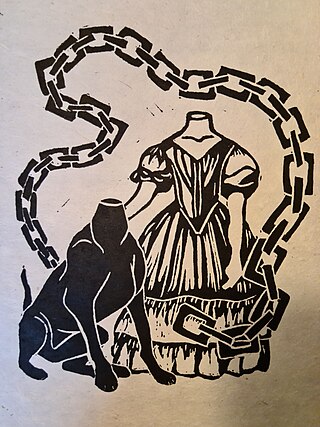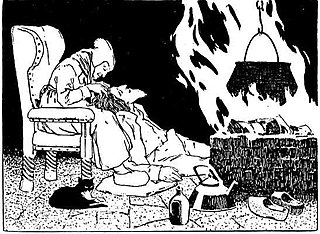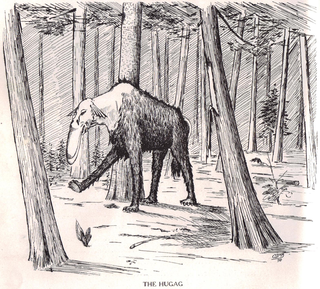
Bigfoot, also commonly referred to as Sasquatch, is a large, hairy mythical creature said to inhabit forests in North America, particularly in the Pacific Northwest. Bigfoot is featured in both American and Canadian folklore, and since the mid-20th century has grown into a cultural icon, permeating popular culture and becoming the subject of its own distinct subculture.

A boggart is a supernatural being from English folklore. The dialectologist Elizabeth Wright described the boggart as 'a generic name for an apparition'; folklorist Simon Young defines it as 'any ambivalent or evil solitary supernatural spirit'. Halifax folklorist Kai Roberts states that boggart ‘might have been used to refer to anything from a hilltop hobgoblin to a household faerie, from a headless apparition to a proto-typical poltergeist’. As these wide definitions suggest boggarts are to be found both in and out of doors, as a household spirit, or a malevolent spirit defined by local geography, a genius loci inhabiting topographical features. The 1867 book Lancashire Folklore by Harland and Wilkinson, makes a distinction between "House boggarts" and other types. Typical descriptions show boggarts to be malevolent. It is said that the boggart crawls into people's beds at night and puts a clammy hand on their faces. Sometimes he strips the bedsheets off them. The household boggart may follow a family wherever they flee. One Lancashire source reports the belief that a boggart should never be named: if the boggart was given a name, it could neither be reasoned with nor persuaded, but would become uncontrollable and destructive.

In folklore, a mermaid is an aquatic creature with the head and upper body of a female human and the tail of a fish. Mermaids appear in the folklore of many cultures worldwide, including Europe, Asia, and Africa.
American mythology is the body of traditional stories pertaining to America's most legendary stories and folktale, dating back to the late 1700s when the first colonists settled. "American mythology" may also refer to the modern study of these representations, and to the subject matter as represented in the literature and art of other cultures in any period.

The jackalope is a mythical animal of North American folklore described as a jackrabbit with antelope horns. The word jackalope is a portmanteau of jackrabbit and antelope. Many jackalope taxidermy mounts, including the original, are made with deer antlers.

The skunk ape is a large and hairy human-like mythical creature purported to inhabit the forests and swamps in the southeastern United States, most notably in Florida. It is often compared to, synonymous with, or called the "cousin" of Bigfoot, a prominent subject within North American popular culture.

The brown trout is a species of salmonid ray-finned fish and the most widely distributed species of the genus Salmo, endemic to most of Europe, West Asia and parts of North Africa, and has been widely introduced globally as a game fish, even becoming one of the world's worst invasive species outside of its native range.

The wild man, wild man of the woods, or woodwose/wodewose is a mythical figure and motif that appears in the art and literature of medieval Europe, comparable to the satyr or faun type in classical mythology and to Silvanus, the Roman god of the woodlands.
Nordic folklore is the folklore of Denmark, Norway, Sweden, Iceland and the Faroe Islands. It has common roots with, and has been under mutual influence with, folklore in England, Germany, the Low Countries, the Baltic countries, Finland and Sápmi. Folklore is a concept encompassing expressive traditions of a particular culture or group. The peoples of Scandinavia are heterogenous, as are the oral genres and material culture that has been common in their lands. However, there are some commonalities across Scandinavian folkloric traditions, among them a common ground in elements from Norse mythology as well as Christian conceptions of the world.

A merman, the male counterpart of the mythical female mermaid, is a legendary creature which is human from the waist up and fish-like from the waist down, but may assume normal human shape. Sometimes mermen are described as hideous and other times as handsome.

Fly tying is the process of producing an artificial fly used by fly fishing anglers to catch fish. Fly tying is a manual process done by a single individual using hand tools and a variety of natural and manmade materials that are attached to a hook. Although the recent history of fly tying dates from the middle 1800s, fly tyers were engaged in tying flys since at least 200 AD.

Kiwa hirsuta is a crustacean discovered in 2005 in the South Pacific Ocean. This decapod, which is approximately 15 cm (5.9 in) long, is notable for the quantity of silky blond setae covering its pereiopods. Its discoverers dubbed it the "yeti lobster" or "yeti crab".
The wulver or wullver is a kind of wolf-like humanoid creature in the folklore of the Shetland Islands of Scotland. In modern times, the origin of the wulver has been disputed.
Fenodyree in the folklore of the Isle of Man, is a hairy supernatural creature, a sort of sprite or fairy, often carrying out chores to help humans, like the brownies of the larger areas of Scotland and England.

"Allerleirauh" is a fairy tale recorded by the Brothers Grimm. Since the second edition published in 1819, it has been recorded as Tale no. 65. Andrew Lang included it in The Green Fairy Book.

"The Devil with the Three Golden Hairs" is a German fairy tale collected by the Brothers Grimm. It falls under Aarne–Thompson classification types 461, and 930.

In North American folklore and American mythology, fearsome critters were tall tale animals jokingly said to inhabit the wilderness in or around logging camps, especially in the Great Lakes region. Today, the term may also be applied to similar fabulous beasts.

The Mogollon Monster, also known as the Arizona Bigfoot, is an ape-like creature, similar to descriptions of Bigfoot, reported to dwell in central and eastern Arizona along the Mogollon Rim.

The wildlife of Iceland is the wild plant and animal life found on the island of Iceland, located in the north Atlantic Ocean just south of the Arctic Circle. The flora, fauna, and funga is limited by the geography and climate of the island. The habitats on the island include high mountains, lava fields, tundras, rivers, lakes and a coastal plain of varying width. There is a long coastline, much dissected by fjords, especially in the west, north and east, with many offshore islets. The entire country is a single ecoregion, the Iceland boreal birch forests and alpine tundra.

The Wulff series of dry flies evolved from a dry fly style conceived by angler Lee Wulff in the 1930s.
















